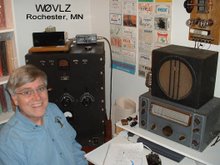

Ads featured the Junior as
an exceptional and outstanding value, especially recommended for the beginner and as the nucleus for a more powerful CW or phone transmitter. Experienced hams could even use this as an inexpensive standby or emergency transmitter. At $15.95 (less tubes, meter and crystal) this "professionally styled" 25 watt transmitter was heralded as the biggest bargain in the history of radio. With only two crystals it could cover 160-20 meters. It was the most amazing opportunity ever offered aspiring DXers. It could always added to without junking parts ( All Wave Radio, November 1937, pg 613).With hype like this how could I pass one up when it was offered to me in a trade?

My Utah Jr was sold in the ARRL auction a few years ago.
 In general it was in pretty good shape with only a single obvious mod. Someone had done a nice job of adding a jeweled pilot lamp to the front panel. Pulling the RF deck revealed additional modifications to change the output to a pi network plus a variety of questionable caps, resistors and RF chokes, but no major problems. The power supply had already been recapped. It just needed a new bleeder resistor and three wire cord.
In general it was in pretty good shape with only a single obvious mod. Someone had done a nice job of adding a jeweled pilot lamp to the front panel. Pulling the RF deck revealed additional modifications to change the output to a pi network plus a variety of questionable caps, resistors and RF chokes, but no major problems. The power supply had already been recapped. It just needed a new bleeder resistor and three wire cord.Restoration consisted mostly of backing out the RF Deck mods. The manual mentions wiring the loading capacitor in series with the antenna. This is needed for low impedance antennas. Given today's 50 ohm coax fed antenna systems this was the one change I made from stock. This then lead to dealing with the restricted loading range limited by the 250 mmf loading capacitor. I changed the coil socket to a five pin socket. This allows one pin to be grounded. Now I can add fixed additional loading capacitance as needed to the plug in coil to get close to 50 ohms. The stock 250 mmf loading cap is then used for the fine tuning/loading.
 As an additional change I added easily removed binding posts to the back of the loading cap so that I can play with the fixed additional loading capacitors as needed.
As an additional change I added easily removed binding posts to the back of the loading cap so that I can play with the fixed additional loading capacitors as needed.(My thanks to John Dilks, K2TQN, for his work to post a clean copy of the Utah Jr manual and schematic.)
Addendum, May 31, 2014:
Yesterday both K9LW and K8MRS reported a fine sounding signal. Another vintage transmitter is back on the air.




No comments:
Post a Comment